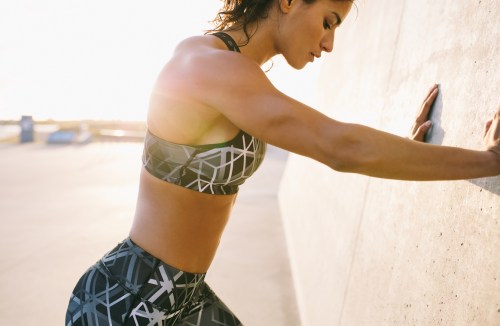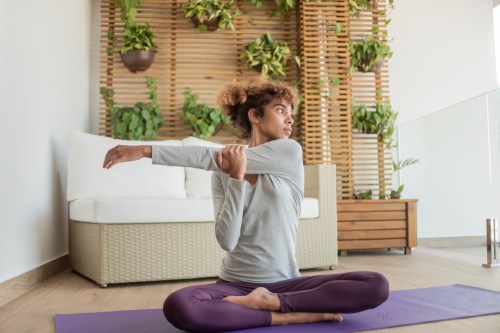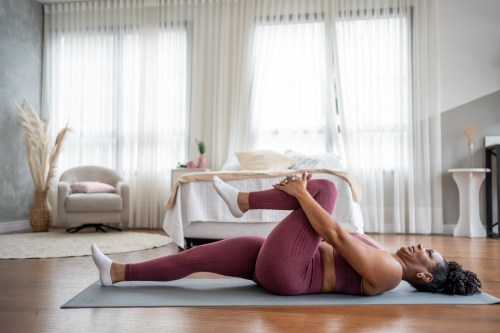New Research Finds Stretching May Help Guard Your Heart Against ‘Arterial Stiffness’
New research finds that stretching is beneficial for arterial stiffness. Here are some daily stretches straight from a yoga teacher to try.

When you think about the best exercises for heart health, stretching might not immediately come to mind. After all, cardio workouts—like running, biking, or HIIT—gets most of the clout when it comes to lowering your blood pressure, strengthening your ticker, and diminishing your risk of cardiovascular disease. (And hey, that rep is well deserved.) But researchers are taking a closer look at how stretching and mobility plays into your cardiovascular system, and it turns out that certain stretches may delay something called “arterial stiffness.”
Experts in This Article
board-certified cardiologist and senior medical lead for Google Fit
founder of Yoga Medicine
Let’s face it: Arterial stiffness doesn’t sound great, but according to Kapil Parakh, MD, a board-certified cardiologist and medical lead for Fitbit, it’s a natural part of the aging process. “When we are babies, our arteries or blood vessels are loose and flexible, sort of like a trampoline. As a result, blood flows easily through them and it does not take much effort from the heart. As we get older, the arteries begin to harden or get stiff. Imagine trying to jump on a pavement instead of the trampoline,” he explains. As your arteries become more rigid, your heart has to work harder to get blood around the body, which can lead to an increased risk of cardiovascular disease and dementia.
Although arterial stiffness is an inevitable part of life, it’s possible to slow it with cardiovascular exercise and—now, as researchers have come to find—stretching. A 2020 meta-analysis published in The International Journal of Environmental Research and Public Health looked into the stretching habits of 213 subjects and found something interesting about their hearts. “This study reviewed all the prior studies done that looked at stretching in middle aged or older adults,” explains Dr. Parakh. “They found eight studies that met the criteria, and combining the results showed that stretching exercises reduced arterial stiffness and improved the health of the blood vessel (technically known as endothelial function). There was also a modest reduction in resting heart rate and blood pressure.”
It’s also important to consider the entirety of the regimen subjects were participating in, says Tiffany Cruikshank, RYT, yoga instructor, licensed acupuncturist, and founder of Yoga Medicine. “Another key is that the intervention groups were performing stretching practices with no other combined training and compared to a control group who continued their regular lifestyle habits. This is important because it helps to rule out that the effects might’ve come from other activities they were doing at the time,” she explains.
Plus, the duration of the studies clocked in at only four weeks—meaning that these effects took place rapidly, and future studies could explore how stretching has an even greater effect over longer periods of time.
While research has yet to pinpoint what specific types of stretches would best yield these arterial benefits, it does reaffirm that daily stretching gives you rewards that go way beyond relieving ing muscle tension. “This study does not tell us specifics related to stretching, positions, frequency, or duration, but it does suggest that a regular stretching routine can reduce arterial stiffness, heart rate, diastolic blood pressure, and improve vascular endothelial function in middle-aged—forty-plus—and older adults,” says Cruikshank. Dr. Parakh adds that stretching can also help you dial back your stress levels, reduce inflammation, and cool down after a sweaty workout.
Remember: “More research is needed for details on stretching styles, lengths, and frequency; however I think this is a very good start and points strongly to the effect that stretching alone can have on the cardiovascular system,” she says. Below Cruikshank shares three stretches she recommends adding to your routine regularly. Ready? Let’s stretch.
3 stretches that may help combat arterial stiffness
1. QL stretch
Come to seated and extend both legs out in front of you. Bring your right foot to the inside of your left thigh, sitting up as straight as you can. Walk your hands forward toward your foot, then cross them over outside your left leg until you feel a stretch in your lower back. Rest here for a few minutes before slowly coming out of the pose and switching to the opposite side.
2. Shoulder extension
Come to lie down on your back and prop yourself up on your elbows. Walk your elbows back as far as you comfortably can. Gently tilt your chin toward your chest to relax your neck. Make sure your neck, shoulders, and jaw are completely relaxed. Hang out here for a couple minutes.
3. Quadricep stretch
Come to kneel on your shins, sitting your butt on your heels. Place your hands behind you, arms straight, for support, and spread your knees so they’re wider than your hips (your toes should still touch). Tuck your tailbone under to feel a stretch on the front side of your thighs. You can deepen the stretch by walking your hands farther back away from you or coming down onto your elbows. As with the other stretches, stay here for a few minutes, paying attention to your breath.
Keep the stretches going with this lower back stretch session:
Oh hi! You look like someone who loves free workouts, discounts for cutting-edge wellness brands, and exclusive Well+Good content. Sign up for Well+, our online community of wellness insiders, and unlock your rewards instantly.
Sign Up for Our Daily Newsletter
Get all the latest in wellness, trends, food, fitness, beauty, and more delivered right to your inbox.
Got it, you've been added to our email list.










